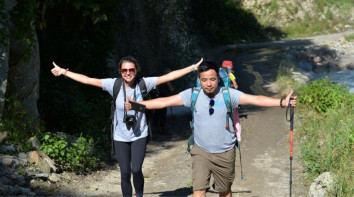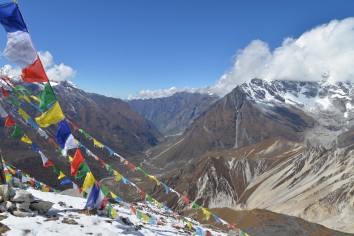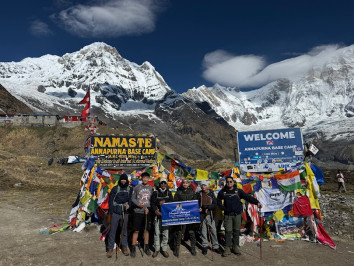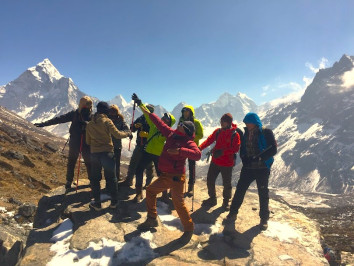25th Feb, 2025

The Mardi Himal Trek Spring Session is a short Trekking destination in the Annapurna Region; it lies in western Nepal (Gandaki Province) and is preserved by Annapurna Conservation. The trek can start from Pokhara, and it takes 4 to 6 days depending on the client’s fitness. These trekking routes were recently opened and managed by the local community. The Mardi Himal Trek is popular with three sessions, but the spring season (March-May) is an excellent choice. The trekkers can see magnificent views with many types of colorful rhododendrons and moderate weather conditions.
Table of Contents
Mardi Himal Trek Itinerary
A well-planned Mardi Himal Trek itinerary is essential for making the most of your Himalayan adventure. This scenic trek typically takes 5 to 7 days, starting from Kande near Pokhara and ending at Siding village. The standard route passes through Deurali, Forest Camp, Low Camp, High Camp, and the final destination: Mardi Himal Base Camp (4,500 meters). Trekkers experience varied terrain, from lush rhododendron forests to high alpine ridges with breathtaking views of Machapuchare (Fishtail), Annapurna South, and Hiunchuli. The return journey descends via Siding village, offering a different scenic route. This Mardi Himal Trek itinerary is flexible and ideal for both novice and experienced trekkers. Add a buffer day for acclimatization or exploration. Whether self-guided or with a group, this itinerary ensures a well-balanced trek combining adventure, culture, and stunning Himalayan views.
Outline itinerary
- Day 01: Kathmandu to Pokhara, drive 210 km (6–8 hours by tourist bus), by flight 25 m, 810 m
- Day 02: Pokhara to Kande 1 hrs, 27 km by car, Trek to Deurali, 8–10 km (3–5 hrs)2125 m.
- Day 03: Trek from Deurali to Forest Camp, 7 km (5–6 hrs), 2600 m.
- Day 04: Trek from Forest Camp to Badal Danda, 3210 m, 6 km (4–5 hrs)
- Day 05: Trek from Badal Danda to High Camp 3580 m, 4 km (3–4 hrs)
- Day 06: High Camp to Mardi Himal Viewpoint 4500 m, Return to Low Camp 3,050 m, 12 km, 7–8 hrs
- Day 07: Trek from Low Camp to Sidhing 1700 m, 3 hrs drive to Pokhara 810 m.
- Day 08: Pokhara to Kathmandu, 6–8 hrs by tourist bus, 25 min flight ($120 per person)
- Day 09: Departure from Nepal International Airport to your own destination
Mardi Himal vs Annapurna Base Camp
Choosing between Mardi Himal and Annapurna Base Camp (ABC) depends on your trekking preferences. Mardi Himal is a shorter and quieter trail, taking about 5–7 days, while ABC requires 7–12 days and sees more foot traffic. Mardi offers intimate views of Machapuchare (Fishtail) and is ideal for trekkers seeking off-the-beaten-path experiences. In contrast, ABC provides dramatic close-up views of the entire Annapurna massif and a chance to visit the famous Annapurna Sanctuary. While both require a TIMS card and an ACAP permit, ABC has more established infrastructure and villages along the way. For trekkers seeking a peaceful trek with ridge-top views, Mardi Himal is an ideal choice. For those seeking a classic Himalayan experience with diverse terrain and cultural encounters, ABC is the better choice. Both treks start from Pokhara and are excellent options in the Annapurna region.
Best Time to Trek Mardi Himal
The best time to trek Mardi Himal is during the spring (March to May) and autumn (September to November) seasons. In spring, blooming rhododendron forests add vibrant color to the trail, while autumn offers clear skies, stable weather, and crystal-clear mountain views. These periods provide the most favorable trekking conditions with mild temperatures and good visibility of peaks like Machapuchare, Annapurna South, and Mardi Himal. Winter (December–February) is possible but very cold, especially at High Camp. Monsoon (June–August) is not recommended due to slippery trails, leeches, and poor visibility. If you're planning a Mardi Himal trek, check local weather updates and try to schedule your hike during peak trekking seasons for the best experience. These months also offer more open teahouses, safer trails, and better photo opportunities.
Mardi Himal Weather Forecast
Checking the Mardi Himal weather forecast is essential before and during your trek. Weather in the Annapurna region can be unpredictable, especially at higher elevations like High Camp and Mardi Himal Base Camp (4,500m). During peak trekking seasons (spring and autumn), you can expect clear skies, moderate temperatures, and excellent visibility. Average daytime temperatures range between 10°C to 20°C, but can drop below -5°C at night at higher altitudes. In winter, expect heavy snowfall, icy trails, and sub-zero temperatures. Monsoon months (June–August) bring frequent rain, cloud cover, and slippery paths. Always check a reliable Himalayan trekking weather app or forecast site before starting your trek. Keeping track of the weather in Mardi Himal ensures safety and helps you plan acclimatization and summit days more effectively.
Altitude Sickness on Mardi Himal Trek
Altitude sickness on the Mardi Himal Trek is a real risk, especially as you ascend past 3,000 meters to Mardi Himal Base Camp (4,500m). Common symptoms include headache, nausea, dizziness, and shortness of breath. Though the Mardi route is considered moderate in difficulty, rapid altitude gain can still cause Acute Mountain Sickness (AMS) if not managed properly. To prevent altitude sickness, take your time ascending, stay hydrated, and avoid alcohol. Most itineraries include overnight stays at Forest Camp, Low Camp, and High Camp, which help with acclimatization. If symptoms worsen, descend immediately. Carry medications like Diamox, and always consult your guide or a doctor if needed. Understanding the risks of AMS on Mardi Himal and preparing accordingly ensures a safe and enjoyable trek in the Annapurna region.
Mardi Himal Trek Map
A Mardi Himal Trek map is an essential tool for route planning, navigation, and understanding elevation gain. The trek starts at Kande (1,770m) and winds through Deurali, Forest Camp, Low Camp, High Camp, and finally Mardi Himal Base Camp (4,500m). A good trekking map shows trail distances, altitudes, village locations, and alternative descent routes via Siding or Lwang villages. Physical maps are available in Pokhara trekking shops, while digital versions are accessible on GPS trekking apps like Maps.me or Gaia GPS. For solo trekkers or those without a guide, having a detailed Mardi Himal trail map ensures you stay on track and manage time efficiently. Maps also help identify nearby teahouses, viewpoints, and emergency exit routes. Always carry a waterproof version or an offline map for safety.
7. Pokhara to Mardi Himal Trek
The journey from Pokhara to the Mardi Himal trek typically starts with a 1-hour drive to Kande, the main trailhead. Pokhara, Nepal’s second-largest city and a gateway to the Annapurna region, offers easy access to permits, guides, and gear. From Kande, trekkers follow the scenic trail through Deurali, ascending through lush forests to High Camp, eventually reaching Mardi Himal Base Camp. The entire trek takes 5 to 7 days, making it one of the best short treks near Pokhara. Returning is possible via Siding village, with transport options back to Pokhara. The proximity and ease of access make Mardi Himal a perfect trek from Pokhara for those short on time but craving high-altitude adventure. Local tour operators in Pokhara offer guided Mardi Himal packages, or you can organize it independently with a map and permits.
8. Teahouses on Mardi Himal Route
There are plenty of teahouses on the Mardi Himal route, offering basic but comfortable accommodation and meals. You’ll find teahouses at key points like Deurali, Forest Camp, Low Camp, Badal Danda, High Camp, and even some near Mardi Himal Viewpoint. These teahouses typically offer twin-sharing rooms, blankets, and hot meals such as dal bhat, noodles, soup, and tea. Most do not have heating, so bring a warm sleeping bag. Wi-Fi and charging options are limited and may cost extra. Booking in advance is not usually required, except during peak trekking season (March–May and September–November). The Mardi Himal teahouse experience is a great way to connect with locals and fellow trekkers while staying warm and well-fed in the mountains.
9. Guided Mardi Himal Trek Package
A guided Mardi Himal trek package is perfect for trekkers seeking a hassle-free experience. These packages usually include transportation from Pokhara or Kathmandu, trekking permits (TIMS and ACAP), a licensed guide and porter, accommodation in teahouses, and all meals during the trek. Most tour operators offer 5 to 7-day itineraries, customizable to your fitness and time. Having a local guide ensures safety, cultural insight, and navigation support, especially on less-marked sections of the trail. Guided packages also help prevent altitude sickness by managing your pace and acclimatization. Whether you’re a solo traveler or in a group, a Mardi Himal trekking package ensures a smooth, organized adventure with stunning views of Annapurna and Machapuchare. Look for registered trekking companies in Pokhara or Kathmandu with good reviews and ethical practices.
10. Packing List for Mardi Himal Trek
A well-prepared packing list for the Mardi Himal Trek is key to a safe and comfortable journey. Essential items include a warm sleeping bag, a down jacket, thermal layers, trekking poles, sturdy hiking boots, water purification tablets, and a daypack. Don’t forget a headlamp, first-aid kit, sunscreen, and UV-protected sunglasses. For clothing, pack moisture-wicking base layers, fleece, windproof jackets, and a rain poncho, especially during shoulder seasons. A reusable water bottle and snacks are handy on the trail. Teahouses provide basic bedding, but it’s safer to have your
Recent Posts

11th Sep, 2022
.jpg)
11th Sep, 2022

11th Sep, 2022
.jpg)
13th Jan, 2023

14th Mar, 2023
.jpg)
18th Mar, 2023

25th Mar, 2023
.jpg)
30th Mar, 2023

1st Apr, 2023
.jpg)
18th Jul, 2023

10th Mar, 2024

17th Mar, 2024

25th Feb, 2025

19th Mar, 2025

13th Jun, 2025

4th Jul, 2025

10th Aug, 2025

25th Aug, 2025


 WhatsApp
WhatsApp  Plan Your Trip
Plan Your Trip
 (1366 x 768 px).jpg)




